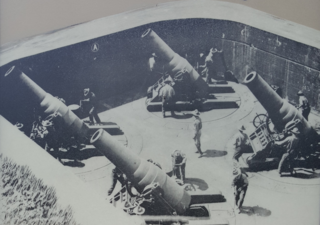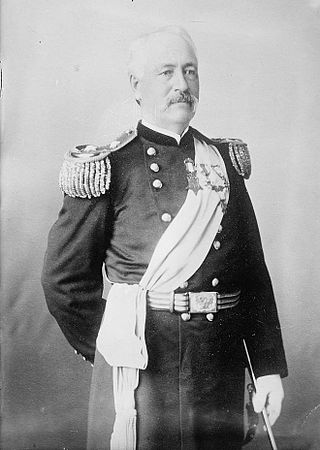Related Research Articles

The 54th Massachusetts Infantry Regiment was an infantry regiment that saw extensive service in the Union Army during the American Civil War. The unit was the second African-American regiment, following the 1st Kansas Colored Volunteer Infantry Regiment, organized in the northern states during the Civil War. Authorized by the Emancipation Proclamation, the regiment consisted of African-American enlisted men commanded by white officers.

The Continental Army was the army of the United Colonies representing the Thirteen Colonies and later the United States during the American Revolutionary War. It was formed on June 14, 1775 by a resolution passed by the Second Continental Congress, meeting in Philadelphia after the war's outbreak. The Continental Army was created to coordinate military efforts of the colonies in the war against the British, who sought to maintain control over the American colonies. General George Washington was appointed commander-in-chief of the Continental Army and maintained this position throughout the war.

United States Colored Troops (USCT) were Union Army regiments during the American Civil War that primarily comprised African Americans, with soldiers from other ethnic groups also serving in USCT units. Established in response to a demand for more units from Union Army commanders, by the end of the war in 1865 USCT regiments, which numbered 175 in total, constituted about one-tenth of the manpower of the army. Approximately 20% of USCT soldiers were killed in action or died of disease and other causes, a rate about 35% higher than that of white Union troops. Numerous USCT soldiers fought with distinction, with 16 receiving the Medal of Honor. The USCT regiments were precursors to the Buffalo Soldier units which fought in the American Indian Wars.

The Bureau of Colored Troops was created by the United States War Department on May 22, 1863, under General Order No. 143, during the Civil War, to handle "all matters relating to the organization of colored troops." Major Charles W. Foster was chief of the Bureau, which reported to Adjutant General Lorenzo Thomas. The designation United States Colored Troops replaced the varied state titles that had been given to the African-American soldiers.

Fort Slocum, New York was a US military post which occupied Davids Island in the western end of Long Island Sound in the city of New Rochelle, New York from 1867 to 1965. The fort was named for Major General Henry W. Slocum, a Union corps commander in the American Civil War.

The 3rd Cavalry Regiment, formerly 3rd Armored Cavalry Regiment is a regiment of the United States Army currently stationed at Fort Cavazos, Texas.

The 28th United States Colored Infantry, also called the 28th Indiana Infantry (Colored),1 was an African American infantry regiment from the state of Indiana that fought in the American Civil War.
Camp William Penn was a Union Army training camp located in Cheltenham Township, Pennsylvania from 1863 to 1865, notable for being the first training ground dedicated to African American troops who enlisted in the United Army during the American Civil War. Some 11,000 free blacks and escaped slaves were trained here, including 8,612 from Pennsylvania, the most black troops recruited during the war from any northern state.
The 1st United States Sharpshooters were an infantry regiment that served in the Union Army during the American Civil War. During battle, the mission of the sharpshooter was to kill enemy targets of importance from long range.

The 13th Infantry Regiment is a United States Army infantry regiment whose battalions are currently tasked as basic training battalions.
Camp Thomas was a United States Regular Army training facility located in North Columbus, Ohio, during the American Civil War. It was primarily used to organize and train new infantry regiments for service in the Western Theater.

"Marching Song of the First Arkansas Colored Regiment" is one of the few Civil War-era songs inspired by the lyrical structure of "The Battle Hymn of the Republic" and the tune of "John Brown's Body" that is still performed and recorded today. The "Marching Song" has been described as "a powerful early statement of black pride, militancy, and desire for full equality, revealing the aspirations of black soldiers for Reconstruction as well as anticipating the spirit of the civil rights movement of the 1960s." The song's lyrics are attributed to the regiment's white officer, Captain Lindley Miller. An almost identical song, "The Valiant Soldiers," is attributed to Sojourner Truth in post-Civil War editions of her Narrative. Recent scholarship supports Miller as the original author, or at least compiler, of the song.

The state of New York during the American Civil War was a major influence in national politics, the Union war effort, and the media coverage of the war. New York was the most populous state in the Union during the Civil War, and provided more troops to the U.S. army than any other state, as well as several significant military commanders and leaders. New York sent 400,000 men to the armed forces during the war. 22,000 soldiers died from combat wounds; 30,000 died from disease or accidents; 36 were executed. The state government spent $38 million on the war effort; counties, cities and towns spent another $111 million, especially for recruiting bonuses.
The history of the United States Army began in 1775. From its formation, the United States Army has been the primary land based part of the United States Armed Forces. The Army's main responsibility has been in fighting land battles and military occupation. The Corps of Engineers also has a major role in controlling rivers inside the United States. The Continental Army was founded in response to a need for professional soldiers in the American Revolutionary War to fight the invading British Army. Until the 1940s, the Army was relatively small in peacetime. In 1947, the Air Force became completely independent of the Army Air Forces. The Army was under the control of the War Department until 1947, and since then the Defense Department. The U.S. Army fought the Indian Wars of the 1790s, the War of 1812 (1812–15), Mexican–American War (1846-1848), American Civil War (1861–65), American Indian Wars, Spanish–American War (1898), World War I (1917–18), World War II (1941–45), Korean War (1950–53) and Vietnam War (1965–71). Following the Cold War's end in 1991, Army has focused primarily on Western Asia, and also took part in the 1991 Gulf War and war in Iraq, and the war in Afghanistan.

Henry Clay Merriam was a United States Army general. He received the United States military's highest decoration, the Medal of Honor, for his actions as a Union officer in command of African American troops during the American Civil War. He later served in various Indian Wars throughout the western United States and commanded the 7th Infantry Regiment. After being promoted to brigadier general, he took on a training and supply role during the Philippine–American War.
United States Volunteers also known as U.S. Volunteers, U.S. Volunteer Army, or other variations of these, were military volunteers called upon during wartime to assist the United States Army but who were separate from both the Regular Army and the militia.
The 11th United States Colored Infantry was an infantry regiment that served in the Union Army during the American Civil War. The regiment was composed of African American enlisted men commanded by white officers and was authorized by the Bureau of Colored Troops which was created by the United States War Department on May 22, 1863.

William Gould (W.G.) Raymond (1819–1893), a pastor, chaplain and American soldier in the Union Army during the American Civil War, played a prominent role in the initial recruitment of the first federal African American regiments of the Union Army. In the period between the Emancipation Proclamation and the establishment of the Bureau of Colored Troops in 1863, Raymond, along with J.D. Turner, received authorization from President Abraham Lincoln to recruit and command the first federal African-American Union Army troops from the District of Columbia. Prior to this, African-American troops were raised at the state level only, without the direct authorization of Lincoln. The troops recruited by Raymond and Turner would become the 1st United States Colored Infantry Regiment and the first regiment of the United States Colored Troops (U.S.C.T), enduring threats and significant obstacles, but ultimately serving with distinction.

Camp Greene was the site of a training camp for the 1st United States Colored Infantry Regiment and other Colored Troops on Mason's Island, now known as Theodore Roosevelt Island, in Washington, D.C. The island was also a refugee camp for freedom seekers. It is situated in the Potomac River. It has been made an Underground Railroad site on the National Park Service's Network to Freedom.

The 16th Texas Infantry Regiment was a unit of volunteers recruited in Texas that fought in the Confederate States Army during the American Civil War. George Flournoy, the former Attorney General of the state of Texas, organized the regiment at Camp Groce in March 1862. Its entire career was spent west of the Mississippi River in the Trans-Mississippi Department. It marched to Arkansas where it camped during the winter of 1862–1863. During that period, the unit was assigned to the 3rd Brigade of the Texas infantry division later known as Walker's Greyhounds. In June 1863, it fought at Milliken's Bend and in October 1863 it skirmished at Opelousas, Louisiana. The regiment was in action at Mansfield, Pleasant Hill, and Jenkins' Ferry in 1864. The regiment disbanded at the end of April 1865, but Flournoy and some soldiers crossed into Mexico and fought for Maximilian I of Mexico. Littleton W. Moore, who fought with the regiment, later became a United States congressman.
References
- ↑ Cornish (1965) p. 130.